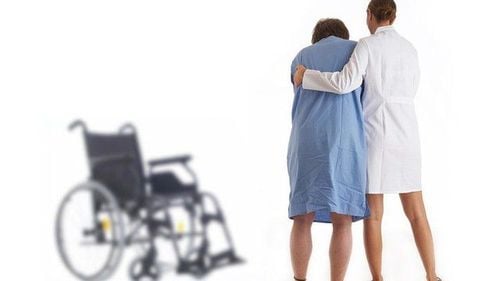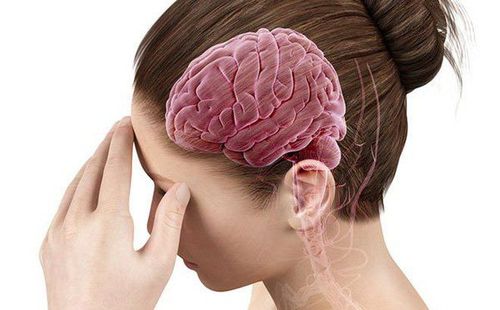This is an automatically translated article.
Hemiplegia due to a stroke is a case where a patient has paralysis of one arm, one leg and half of the face on the same side. So what is the correct position for a patient with hemiplegia to lie down? Read the article below to know and practice the lying position for stroke patients.1. Approaching stroke patients
There are many causes of hemiplegia. It may be due to cerebrovascular accident, traumatic brain injury, or paralysis appears slowly and gradually increases silently and slowly, common in cases of growing mass, paralysis appearing from gradually, gradually progressing in a stepwise fashion often due to degenerative diseases (amyotrophic lateral sclerosis,...). Among them, hemiplegia due to stroke is the most common cause. However, what position is the best position for a person with a stroke for recovery and treatment?Correct patient posture is important to maintain body alignment and comfort; prevent damage to the musculoskeletal system and joints; and provide sensory, motor and cognitive stimulation. A patient with reduced mobility, decreased sensation, impaired circulation, or lack of voluntary muscle control may develop damage to the musculoskeletal and skeletal systems while lying down.
Therefore, when you are a caregiver for a person with hemiplegia, you master the right lying positions to reduce this risk by maintaining unrestricted circulation and adjusting the body while rotating. person or position the patient. The term body alignment refers to the condition of joints, tendons, ligaments, and muscles in different locations on the body. When the body is in alignment, whether standing, sitting or lying down, no undue stress is placed on these structures. Body alignment means that the body conforms to the pull of gravity and contributes to body balance.

Liệt nửa người do tai biến là trường hợp rất thường gặp ở bệnh nhân tai biến
2. Correct lying position for patients with hemiplegia
All the lying positions for stroke patients below are recommended to apply to patients 72 hours after stroke and every 3-4 hours to change position for the patient.2.1. Placing hemiplegic patients in the supine position: Place the head of the bed flat, the patient's head must be placed on a pillow of suitable height so that the patient has neck fatigue, does not fold the cervical vertebrae, eyes straight Place a folded towel or small pillow under the affected shoulder or side Hold the affected arm away from the body with elbows extended and palms up. Place the affected hand in one of the recommended positions for a tender or spastic hand. (Alternative is to put arms to the side, elbows bent, and hands toward the head of the bed.) Place a folded towel under the hip of the paralyzed side to bring the hip of the paralyzed side forward Bend the affected knee to 30 degrees by place your knees on a pillow or folded blanket Support your feet with a soft pillow at the heel. 2.2. Place the hemiplegic patient in a semi-Fowler or supported Fowler position Place the patient in the supine position. Raise the head of the bed from 45 to 60 degrees. Place the patient in the Fowler position as straight as possible. Place your head on a small pillow with your chin slightly forward. If the patient is completely unable to control head movement, avoid a poorly immobilized neck. Place a small rolled towel under the lumbar region of the back - support for the lumbar spine. Support the arm and hand involved by placing the arm away from the patient and supporting the elbow with a pillow. Place a rolled blanket or sandbag firmly along the patient's feet. Support the foot in padding with a therapeutic boot or brace. 2.3. Place the hemiplegic patient in a lying position on the healthy side. The patient's head lies on a pillow that is medium enough to not affect the cervical vertebrae, the pillow firmly fixes the head so that it does not move too much. Handrails below and place the patient. The patient lies on the side of the bed facing the direction the patient will be turned. Move the upper body, support the front shoulder; then move the lower body, supporting the hips Bend the patient's knee that is not next to the mattress. Keep your feet on the mattress. Place one hand on the patient's upper bent leg near the hip, and place the other hand on the patient's shoulder. Pull the patient to lie on your side Place a pillow under the patient's head and neck Place your hands under the patient's dependent shoulder and bring the shoulder blades forward, this prevents the patient's weight from pressing directly on the shoulder joint Place both arms in a slightly bent position. Upper arm support at shoulder level; other arm, with mattress Place hand under hip and slightly forward hip so hip to mattress angle is approximately 30 degrees Place small pillow behind patient's back (Done by folding knee lengthwise. Smooth area. is placed slightly under the patient's back.) Place a pillow under the semi-flexed leg at hip level from groin to foot. An ankle-foot orthotic may be used on the foot, if available.

Bệnh nhân tai biến nằm tư thế nào phù hợp là thắc mắc của nhiều người
Please dial HOTLINE for more information or register for an appointment HERE. Download MyVinmec app to make appointments faster and to manage your bookings easily.
Reference source: slideplayer.com












